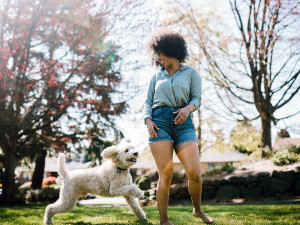A Walk a Day Keeps the Doggie Dementia Away
A new study finds that physical exercise could keep your dog sharp. Time for walkies!
No shocker here: Pet parents have an especially bad reaction to the idea of a dog’s mortality. As if to prove this point, there is an actual website opens in new tab with the sole purpose of warning people if a dog dies in a movie. Preferably, we want our pups to live forever. And if that’s not possible, the Dog Aging Projectopens in new tab (DAP) is working to give dog parents get the next best thing: A long and healthy life for their dog.
By collecting dataopens in new tab on a large sample of dogs across the country, the multi-year project seeks to uncover the most important genetic and environmental influences on dog longevity. For their latest research, the DAP teamed up with the University of Washington to study cognitive decline, one particularly difficult aspect of aging.
Snap a pic of your pup’s teeth, and GREENIES™ will help you spot potential signs of oral health issues.
How the Dog Aging Project Studied Dementia in Dogs
This research, published in Scientific Reportsopens in new tab in August, was one of the largest on canine cognition to date. Over 15,000 dogs were included in the analysis — a mix of pups of different breeds, ages, and geographic locations.
For each dog, researchers considered two sets of data: The first was a comprehensive survey that owners filled in upon first enrolling in the Dog Aging Project. This provided baseline information on the dog’s breed, age, diet, activity level, medical history, etc. Shortly after enrolling, dog parents answered the Canine Social and Learned Behavior (CSLB) survey, a clinically validated survey that asks 13 questions to predict if a dog has canine cognitive decline (CCD), also known as doggy dementia.
How much do you spend on your pet per year?
Tell-tale signs of CCDopens in new tab include getting stuck behind objects, incontinence, lack of focus, and failing to recognize familiar people and objects. Based on this survey, 1.4 percent of dogs in the study had CCD. The researchers then compared these surveys to see which characteristics were correlated with CCD risk.
What the Researchers Found
For starters, the most accurate predictor of CCD was a dog’s age. The odds of developing the condition increased 52 percent with each additional year ��— and this was true regardless of breed or sex. “The biology of aging is really the most important risk factor for whether or not a dog or a person is going to develop dementia,” Matt Kaeberlein, Ph.Dopens in new tab., the Dog Aging Project Co-Director, tells Kinship.
“When you get past age, the next strongest risk factor that was identified was activity level,” Kaeberlein adds. The odds of CCD were 6.47 times higher in dogs who were not active compared to those who were very active.
Physical activity is a major protective factor against dementia and Alzheimer's diseaseopens in new tab in humans, in part because of the way it engages our brains. Exercising has been shown to reduce inflammatory brain proteinsopens in new tab, improve neuroplasticityopens in new tab, and even increase the size of the hippocampusopens in new tab — a brain region responsible for learning and memory. Kaeberlein says he wouldn’t be surprised if the same biological mechanisms were at play in dogs.
The study also found that dogs with a history of neurological, eye, or ear disorders had higher odds of CCD. And for a factor that didn’t seem to impact the likelihood of developing CCD? A dog’s size. Both big dogs and small dogs had equal risk — a somewhat surprising finding. “Big dogs seem to age biologically faster than small dogs do. That doesn’t seem to be the case for cognitive function, which is really interesting,” Kaeberlein says.
Before you take these findings as facts, Kaeberlein warns that the study does have its limitations. For starters, it only collected data on a dog’s CCD risk at one point in time. As the project continues, it will gather data on how dogs’ cognitive health changes over their lifespan. Kaeberlein also suspects that the owners of very sick dogs might not want to enroll them in a long-term health study. Finally, correlation does not necessarily mean causation, and dogs may be less physically active because they have CCD, not the other way around.
Even with these caveats, Kaeberlein does think that the finding that physical activity can keep dogs mentally sharp holds weight. “I absolutely believe that there is a real protective effect in both dogs and people from exercise,” he says.
How It Applies to You
This new research is yet another reason to keep your dog active by going on regular walks, runs, and having play sessions together. Not only could it help them live a longer life, but it’ll boost your healthopens in new tab, too. Stay tuned for more findings from the Dog Aging Project on how you and your pup can thrive together. In the coming years, the group plans to conduct a variety of types of studies to answer the question: How can dogs and their people live longer and live better?






